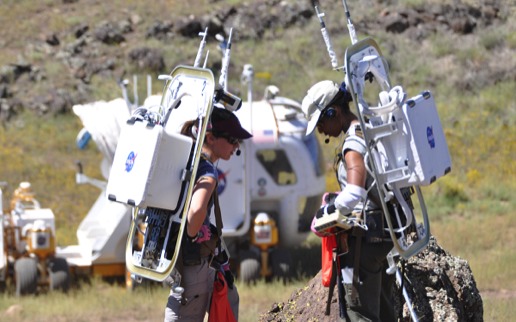⬆ Impact melt flow from the SE flank of Tycho crater on the Moon disrupted by a subsequent, ~ 400-m impact (NASA/GSFC/Arizona State University)
Bolide impact has been the dominant geologic surface process in the inner Solar System over much of its history. Airless bodies such as the Moon and asteroids provide extraordinary, pristine examples of impacted landscapes that inform our process models. Terrestrial impact sites – testimonials to the influence of impact on the evolution of Earth's environment and life itself – illustrate how impact structures are modified on a planet with a fluid envelope. Much of the research of the KVH Group in planetary science focuses on the use of isotopic tools to measure the age of specific impact events and the tempo of meteorite flux.
Our group also has been heavily involved in the development of new, more advanced approaches to planetary field science by humans as well as autonomous and teleoperated robots.
Our group also has been heavily involved in the development of new, more advanced approaches to planetary field science by humans as well as autonomous and teleoperated robots.
Active Projects
The Chronology of Terrestrial Impacts
A very small number of the events responsible for terrestrial impact sites have been dated with accuracy and precision. We are adding to the growing database by dating impact melt (impact geochronology) as well as target materials that have had their isotopic systematics reset or disturbed by impact-related thermal events (impact thermochronology) using the 40Ar/39Ar and (U-Th)/He methods. Sites currently under study in collaboration with many national and international partners include Bosumtwi (led by van Soest), Charlevoix (Biren, van Soest), Haughton (Young), Karikkoselkä (van Soest), Mistastin (Young), Manicouagan (Biren, van Soest), Monturaqui (Wartho), Ries (Cooper/van Soest), Rochechouart (Biren), Saint Martin (Biren, Wartho), Steinheim (van Soest, Wartho), Upheaval Dome (Mercer), West Clearwater (Biren), and Wetumpka (Wartho).
Publications
van Soest, M. C., Hodges, K. V., Wartho, J. A., Biren, M. B., Monteleone, B. D., Ramezani, J., Spray, J. G., and Thompson, L. M., 2011, (U-Th)/He dating of terrestrial impact structures: The Manicouagan example: Geochemistry Geophysics Geosystems, v. 12, p. doi: Q0aa16 10.1029/2010gc003465.
Wartho, J. A., van Soest, M. C., King, D. T., and Petruny, L. W., 2012, An (U-Th)/He age for the shallow-marine Wetumpka impact structure, Alabama, USA: Meteoritics & Planetary Science, v. 47, no. 8, p. 1243-1255.
Young, K. E., M. C. van Soest, K. V. Hodges, E. B. Watson, B. A. Adams, and P. Lee (2013), Impact thermochronology and the age of Haughton impact structure, Canada, Geophysical Research Letters, 40, 3836-3840.
Wartho, J. A., van Soest, M. C., King, D. T., and Petruny, L. W., 2012, An (U-Th)/He age for the shallow-marine Wetumpka impact structure, Alabama, USA: Meteoritics & Planetary Science, v. 47, no. 8, p. 1243-1255.
Young, K. E., M. C. van Soest, K. V. Hodges, E. B. Watson, B. A. Adams, and P. Lee (2013), Impact thermochronology and the age of Haughton impact structure, Canada, Geophysical Research Letters, 40, 3836-3840.
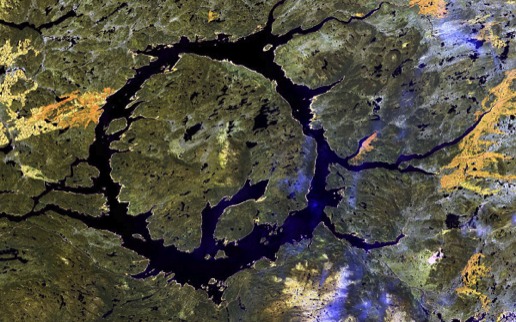
High Spatial-Resolution Geochronology of Apollo 16 and 17 Impact Breccias
The application of 40Ar/39Ar geochronology to whole rocks and mineral separates from impact breccias have provided many constraints on the impact history of the Moon, but questions remain regarding the possible diachroneity of melt materials in Apollo, Luna, and lunar meteorite samples. Predicated on the notion that the in situ dating of impact melts in petrographic context may provide some of the answers, KVH and colleague Brad Jolliff of Washington Univeristy - St. Louis have launched projects that integrate petrologic and laser microprobe 40Ar/39Ar techniques. Most recently, postdoctoral researcher John Weirich and Ph.D. candidate Cameron Mercer have embarked on ArF excimer laser microprobe studies of Apollo 16 and 17 impactites.
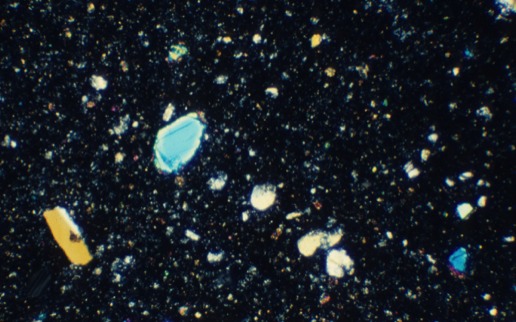
Developing Technologies and Techniques for Robot-Augmented Human Surface Science
In collaboration with Dave Akin (University of Maryland) and SESE colleague Sri Saripalli, our group is perform field simulations of planetary surface science investigations in relevant analogue environments in central and northern Arizona. Our aim is to test different robotics technologies and operations concepts to determine the efficacy and science productivity of each new concept. Using only trained field geologists as test subjects, surface geological exploration tasks are performed in shirtsleeves as a control, then again in a pressure suit or suit simulator for pure extravehicular performance, then with various forms of robotic assistance, and finally in a fully telerobotic mode. In this way, each operational concept can be directly compared to the other viable field science modalities to determine which produces the best science return as a function of time, operator workload, and other metrics of interest.
Publication
Akin, D. L., Saripalli, S., Di Capua, M., Davis, K., Hodges, K., and Young, K., 2011, Field analogue simulations investigating EVA/Robotic collaboraitons in lunar exploraiton: 41st International Conference on Environmental Systems, Paper AIAA 2011-5115.
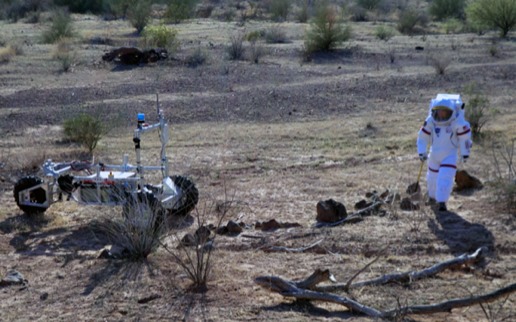
Robotic Precursor and Follow-Up Mission Simulations
In collaboration with the Intelligent Robotics Group at NASA's Ames Research Center (led by Terry Fong) and others, we have participated in a variety of tests of the capabilities of the K10 robot (pictured here, at Haughton crater) to provide important science information in anticipation of human exploration missions and to perform surveys after human exploration teams have moved on.
Publications
Fong, T., Bualat, M., Deans, M. C., Adams, B., Allan, M., Altobelli, M., Bouyssounouse, X., Cohen, T., Flückiger, L., Garber, J., Palmer, E., Heggy, E., Helper, M., Hodges, K., V., Hurtado, J. M., Jurgens, F., Kennedy, T., Kobayashi, L., Landis, R., Lee, P., Lee, S. Y., Lees, D., Lum, J., Lundy, M., Shin, T., Milam, T., Pacis, E., Park, E., Pedersen, L., Schreckenghost, D., Smith, T., To, V., Utz, H., Wheeler, D., and Young, K., 2010, Robotic Follow-up for Human Exploration, Proceedings of AIAA Space 2010, Paper AIAA 2010-8605: Anaheim, CA, p. 1-24.
Bualat, M. G., Abercromby, A., Allan, M., Bouyssounouse, X., Deans, M. C., Fong, T., Flückiger, L., Hodges, K. V., Hurtado, J., Jr., Keely, L., Kobayashi, L., Landis, R., Lee, P. C., Lee, S. Y., Lees, D., Pacis, E., Park, E., Pedersen, L., Schreckenghost, D., Smith, T., To, V., and Utz, H., 2011, Robotic recon for human exploration: Method, assessment, and lessons learned, in Garry, W. B., and Bleacher, J. E., eds., Analogs for Planetary Exploration: Boulder, CO, Geological Society of America Special Paper 483, p. 117-135.
Bualat, M. G., Abercromby, A., Allan, M., Bouyssounouse, X., Deans, M. C., Fong, T., Flückiger, L., Hodges, K. V., Hurtado, J., Jr., Keely, L., Kobayashi, L., Landis, R., Lee, P. C., Lee, S. Y., Lees, D., Pacis, E., Park, E., Pedersen, L., Schreckenghost, D., Smith, T., To, V., and Utz, H., 2011, Robotic recon for human exploration: Method, assessment, and lessons learned, in Garry, W. B., and Bleacher, J. E., eds., Analogs for Planetary Exploration: Boulder, CO, Geological Society of America Special Paper 483, p. 117-135.
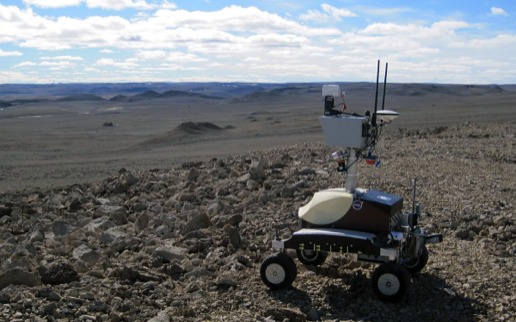
Re-Imagining Planetary Field Geology
In collaboration with colleague and Apollo 17 astronaut Harrison Schmitt and others, we have been designing advanced approaches to planetary field geology that involve human-robot collaborations and provide greater autonomy for astronaut/explorers trained in field geology.
Our group has also been putting these new ideas to the test through field geology training exercises for astronaut candidates from NASA, the Canadian Space Agency (CSA), and the Japanese Space Agency (JAXA), as well as in-service NASA astronauts. Such exercises, led by Dean Eppler and under the auspices of the NASA Astronaut Office will continue with training of a new set of astronaut candidates selected in 2013.
With collaborators Ken Ford and colleagues at the Florida Institute for Human & Machine Cognition and with Cindy Evans at NASA's Johnson Spaceflight Center, we have been exploring the value of hand-held technologies such as x-ray fluorescence spectrometry for sample characterization during field sorties and in laboratories on other worlds.
We have worked extensively with NASA colleagues on planetary field science analogue tests as part of the Desert Research and Technology Studies (DRATS) programs in northern Arizona in recent years, but as participants in science backrooms and as astronaut/explorers in simulated missions. Here Ph.D. candidate Kelsey Young is shown with NASA astronaut Stephanie Wilson at the 2010 test.
Our group has also been putting these new ideas to the test through field geology training exercises for astronaut candidates from NASA, the Canadian Space Agency (CSA), and the Japanese Space Agency (JAXA), as well as in-service NASA astronauts. Such exercises, led by Dean Eppler and under the auspices of the NASA Astronaut Office will continue with training of a new set of astronaut candidates selected in 2013.
With collaborators Ken Ford and colleagues at the Florida Institute for Human & Machine Cognition and with Cindy Evans at NASA's Johnson Spaceflight Center, we have been exploring the value of hand-held technologies such as x-ray fluorescence spectrometry for sample characterization during field sorties and in laboratories on other worlds.
We have worked extensively with NASA colleagues on planetary field science analogue tests as part of the Desert Research and Technology Studies (DRATS) programs in northern Arizona in recent years, but as participants in science backrooms and as astronaut/explorers in simulated missions. Here Ph.D. candidate Kelsey Young is shown with NASA astronaut Stephanie Wilson at the 2010 test.
Publications
Hodges, K. V., and Schmitt, H. H., 2011, A new paradigm for advanced planetary field geology developed through analog experiments on Earth, in Garry, W. B., and Bleacher, J. E., eds., Analogs for Planetary Exploration: Boulder, CO, Geological Society of America Special Paper 483, p. 17-31.
Schmitt, H. H., Snoke, A. W., Helper, M. A., Hurtado, J. M., Hodges, K., V., and Rice, J. W., 2011, Motives, methods, and essential preparation for planetary field geology on the Moon and Mars, in Garry, W. B., and Bleacher, J. E., eds., Analogs for Planetary Exploration: Boulder, CO, Geological Society of America Special Paper 483, p. 1-15.
Eppler, D., Adams, B., Archer, D., Baiden, G., Brown, A., Carey, W., Cohen, B., Condit, C., Evans, C., Fortezzo, C., Garry, B., Graff, T., Gruener, J., Heldmann, J., Hodges, K., Hörz, F., Hurtado, J., Hynek, B., Isaacson, P., Juranek, C., Klaus, K., Kring, D., Lanza, N., Lederer, S., Lofgren, G., Marinova, M., May, L., Meyer, J., Ming, D., Monteleone, B., Morisset, C., Noble, S., Rampe, E., Rice, J., Schutt, J., Skinner, J., Tewksbury-Christle, C. M., Tewksbury, B. J., Vaughan, A., Yingst, A., and Young, K., 2012, Desert Research and Technology Studies (DRATS) 2010 science operations: Operational approaches and lessons learned for managing science during human planetary surface missions: Acta Astronautica, doi: 10.1016/j.actaastro.2012.1003.1009.
